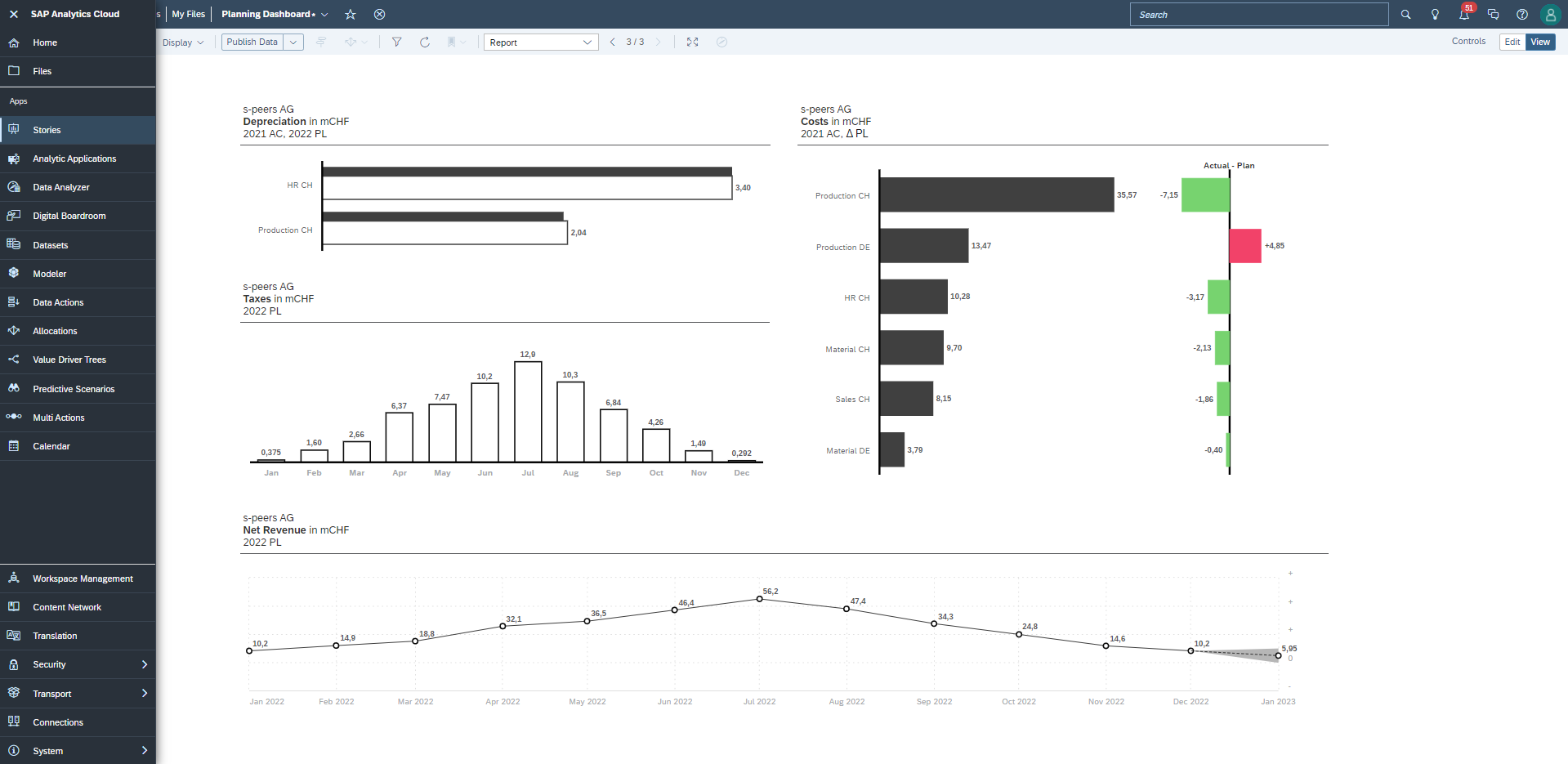Benefits through integrated reporting
Group consolidation both on-premise and in the cloud version: Users of SAP S/4HANA Finance for Group Reporting enjoy numerous benefits through the integrated and very versatile reporting.
Extension of the standard analytics functions
S/4HANA Embedded Analytics is available as standard (e.g. for the easy-to-implement drill-downs down to the individual document level).
No more compromises necessary
All reporting functions possible in integrated reporting: e.g. balance sheet, P&L, cash flow, comprehensive income, change in equity
Additional data evaluation with SAP Analysis for Office
An additional option for data evaluation is the use of the established, Excel-based SAP Analysis for Office (from on-premise release 1809).
Real Time Dashboarding
Interactive real-time dashboarding is also possible with the SAP Analytics Cloud (SAC) as an independent extension. Thanks to integration, planning (including simulations) can be designed via SAC and then consolidated in Group Reporting. If required, combinations of Embedded Analytics, Analysis for Office and SAC can also be realised. In the future, SAP Disclosure Management will also be connected to the Group Reporting system.

What is Group Consolidation and Corporate Reporting?

Thanks to the high-performance in-memory technology of SAP HANA, detailed data analyses can be carried out in real time via SAC, with the service rounded off by an app. The responsive design component allows the display to be adapted to the end device. As an SaaS (software-as-a-service) solution, SAC is very easy to use and cost-effective. By definition, the software is always up-to-date and provides maximum performance. The SAC can also be implemented quickly, giving a productive start at short notice.
What is group consolidation?
"From record to report" means: In the context of the preparation of consolidated financial statements, the legally independent individual companies of a group of companies are combined to form an overall group. In this process, the individual financial statements of the subsidiary units are aggregated in the group currency and all intra-group interrelationships are eliminated.
In order to be able to prepare consolidated financial statements at all, data from various sources must be standardised and presented according to legally or internally defined criteria. If the focus is on legally binding requirements (e.g. IFRS), this is a legal consolidation (incl. balance sheet, P&L, individual segments).
A management consolidation, on the other hand, mainly serves to inform management and therefore follows its guidelines or other internal parameters (especially in terms of organisational structure).
How often do consolidated financial statements have to be prepared?
Another important difference is also the frequency with which the financial statements are prepared: In external group accounting, legally only annual financial statements (audited) and quarterly financial statements (usually unaudited) have to be presented. With regard to internal accounting, however, management usually demands consolidation at much shorter intervals (usually monthly) in order to satisfy its information needs.
What does fast close mean in group consolidation?
At the same time, external stakeholders also increasingly want more transparency through accelerated closings at shorter intervals. The aspect of "fast close" is thus becoming increasingly important, both internally and externally. To meet the complex requirements in all areas of consolidation fully, correctly and as efficiently as possible, companies rely on automated support from SAP software such as SEM-BCS or BCS for BW/4HANA or S/4HANA Finance for Group Reporting.
FAQs Group Consolidation and Corporate Reporting
The customisable consolidation solution SAP SEM-BCS (Business Consolidation System) automates, standardises and simplifies consolidation in your company - for external reporting as well as for internal (management) reporting.
The graphical consolidation monitor always provides a complete real-time overview of all steps, units and progress of the consolidation. This also includes a constant quality check of the data at each step so that any deviations can be reacted to immediately at any time. The information messages (incl. warnings, errors) cover both the business and technical aspects, so that full control is guaranteed at all times.
The document-based BCS software posts manual as well as automatic consolidation facts in accordance with the principles of proper accounting (GoB) and on the basis of posting levels. By means of the individual document types, the transition between reported data, adjusted reported data and consolidated data is fully and transparently traceable at all times: When posting, each document is given an individual number and associated with the corresponding posting level.
SEM-BCS is based on a multidimensional data model in SAP BW, which allows for flexible, correct and automated mapping of all relevant requirements/changes. In parallel, this allows direct access to ERP systems via BI functions, while the consolidation monitor is available as a standardised analysis tool with various reporting options. For example, drill-downs can be carried out down to the level of accounting documents.
In addition, data from other departments and/or applications (e.g. planning, controlling) can be easily integrated into the consolidation process. In terms of compliance, BW-based data collection and storage is ideal: discrepancies between operational accounting and the consolidation system can be efficiently avoided.
In addition, SEM-BCS can also be used to automatically process and form extensive issues such as capital or matrix consolidation (simultaneous execution of legal and management consolidation). Among the other important consolidation functions are, for example:
- Intercompany reconciliation
- Currency conversion
- Validations
- Intercompany accounts
- Intercompany profit elimination in fixed or current assets
- Capital consolidation
Extension packages for SAP SEM-BCS
The SAP maintenance commitment for SEM-BCS (until 31.12.2025) offers investment security and includes various enhancement packages that bring your company the following benefits, among others:
- Expansion to include new regulatory or legal requirements
- New functions regarding consolidation logic
- Increasing performance and user-friendliness
- Optimisation of administration and maintenance
- Improved integration with other components (SAP and non-SAP)
- Optimisation of compliance and auditability
With SAP's HANA strategy, SAP BW has also been optimised for this technology (= SAP BW/4HANA): BW is no longer based on the Netweaver platform - instead, new technical objects ("advanced DataStoreObjects"; aDSO) are used, which have been specially optimised for the performance of the HANA database.
Stringent to this, BCS was also modified for the new BW platform. This modification resulted in the new product "SAP BW/4HANA, Business Consolidation Add-on", which is referred to below as "BCS/4HANA". Version 1.0 of BCS/4HANA has been generally available since 13 February 2019 ("generally available"; Release Note: SAP Note 1330000) and runs on SAP BW/4HANA 1.0.
In addition to the licence for the BW/4HANA platform, the use of BCS/4HANA requires a further licence, which in turn is part of the licence for SAP S/4HANA for Group Reporting: the prerequisite for the use of BCS/4HANA is the licence purchase for 50 consolidation units in S/4HANA for Group Reporting. Customers who have purchased this licence (as well as the licence for SAP BW/4HANA) can thus use BCS/4HANA for an unlimited number of consolidation units (from a commercial perspective).
Information on the technical installation of BCS/4HANA is provided in SAP Note 2684537.
With regard to the conversion from SAP BW to SAP BW/4 HANA, two techniques are available: in-place conversion and remote conversion (both described in SAP Note 2383530). With regard to the change from SEM-BCS to BCS/4HANA, only in-place conversion is currently possible (see SAP Note 2651241).
In terms of functionality, BCS/4HANA 1.0 offers the features of SEM-BCS based on EHP8. However, there are also further innovations.
S/4HANA Finance for Group Reporting is a new SAP consolidation solution available for on-premise use (release 1809) or as a cloud application (release 1811). This solution has a strategic character and combines the functionalities or advantages of the products SAP SEM-BCS and SAP BPC for Consolidation.
The "single source of truth" concept in the form of the HANA database creates a uniform basis: The universal journal located in HANA (individual financial statement data or individual document table of financial accounting; ACDOCA) permanently corresponds with the consolidation data (ACDOCU) on the same platform.
The result is a comprehensive, direct real-time link between the central consolidation system and the operational accounting of the individual business units. In technical terms, this means a certain revolution:
In the case of downstream consolidation outside the operational upstream system (ERP), which has been customary up to now, the data must be transferred to a separate consolidation system for each reporting point in time and harmonised if necessary, as well as validated, sometimes at great expense.
By contrast, via "continuous accounting" with SAP S/4HANA Finance for Group Reporting, consolidation is now performed directly and continuously in the ERP system. This eliminates complex processes for reconciling the data, while automated checks/validations (supported by interactive comments and reporting functions) are also possible directly in the ERP. The conversion of the individual closing values from local or transaction currency into group currency is also carried out continuously and automatically, and this data can also be viewed in real time. At the same time, manual adjustment entries can be made at any time.
Through integrative access to the full spectrum of accounting and controlling data, a management, matrix or capital consolidation can be comfortably realised within the framework of the closing processes in addition to a legal consolidation. With regard to reconciliation between the accounting departments (finance and management), the effort is greatly minimised or eliminated completely, as all financial data have identical account balances as a basis.
Simultaneously, data redundancies are reliably avoided, while data quality, loading and completion speed increase efficiently. Precise logging is also taken care of.
Thanks to the structural direct link between the consolidation and journal entry tables, it is possible to switch from the consolidation level down to the journal entry level - resulting in optimal transparency. Again in real time, there is parallel drag-and-drop access to details (e.g. on cost centres) that cannot be displayed as standard in conventional consolidation concepts. Business users can carry out system control via stored characteristics in the master data (analogous to SAP BPC).
Cloud version of SAP S/4HANA Finance for Group Reporting (Release 1811)
The cloud version of SAP S/4HANA Finance for Group Reporting can be implemented quickly and used very cost-efficiently as a SaaS (Software-as-a-Service) solution: SAP takes care of the hosting and all other IT operating measures (incl. maintenance, updates). Thus, the software always offers up-to-dateness and maximum performance.
The main differences to the on-premise version are the release and update intervals (on-premise: annually, cloud: quarterly) and the associated spectrum of functionalities. This is reflected, among other things, in the fact that the cloud version currently comes with some additional functions for consolidation. These include, for example, new integrated options (report designer, data entry), drill-downs of verification protocols or automated analyses of validation results. Fiori apps make the user interface of the cloud version very clear and user-friendly.
Data connectivity with SAP and non-SAP systems
Data from SAP and non-SAP group companies can be integrated into S/4HANA Finance for Group Reporting with equal efficiency.
Alternatively, data or attachment information from business units without an S/4HANA connection can also be read in conventionally via a programmed interface or captured via upload using the "Data Collection" application. In this case, the respective system type is also irrelevant.
How we support you in the area of group consolidation and corporate reporting
We competently support you in realising your consolidation requirements and your group reporting (internal and external) in a timely manner - automated, maximally efficient and at the required reporting intervals.
Within this framework, we offer you the following services, among others:
- Customised development of uniform technical processes
- Support in designing all necessary data models
- Define the collection and provision of all consolidation and reporting data, including all related relevance data from primary systems.
- Ensure reliable, always up-to-date standards regarding data quality and harmonisation
- Integration of the relevant data of all required reporting events into your existing data warehouse or consolidation system - in compliance with your BI governance
- Harmonisation of your internal and external group reporting
- Modelling of the defined consolidation processes in SAP SEM-BCS, SAP BCS for BW/4HANA and SAP S/4HANA Finance for Group Reporting (on-premise or cloud version)
- Implementation, commissioning and enhancement of SAP SEM-BCS, SAP BCS for BW/4HANA and SAP S/4HANA Finance for Group Reporting (on-premise or cloud version)
- Connection of SAP Disclosure Management to SAP S/4HANA Finance for Group Reporting
- Extend your consolidation and reporting system with integrated solutions for planning requirements (optionally via SAP Analytics Cloud).
- Extension of your consolidation and reporting system with integrated solutions for analytical requirements (optionally via SAP Analytics Cloud)
- Creation of a uniform, meaningful and self-explanatory notation for your group reporting (internal and external) based on the International Business Communication Standards (IBCS®)
We competently support you in realising your consolidation requirements and your group reporting (internal and external) in a timely manner - automated, maximally efficient and at the required reporting intervals.
I look forward to hearing from you!

